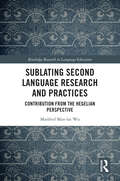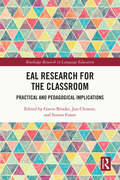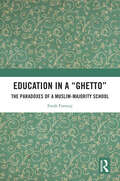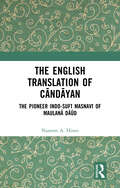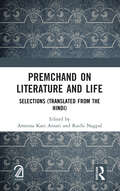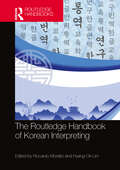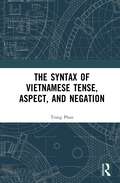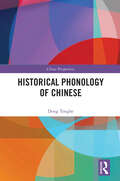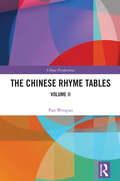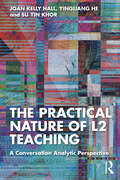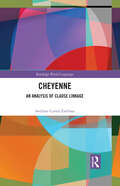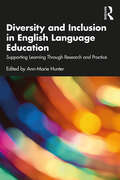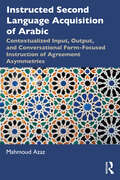- Table View
- List View
Sublating Second Language Research and Practices: Contribution from the Hegelian Perspective (Routledge Research in Language Education)
by Manfred Man-fat WuWu’s book provides an innovative perspective on, and recommendations for, the major aspects of second language (L2) teaching from a Hegelian anthro-philosophical perspective. Language is social in nature and is related to the larger social milieu. Hegelian philosophy of language complements existing research and theories on L2 learning by not only equipping them with a systematic framework but also broadening their scope. In Hegelian philosophy, language not only has its individual and interpersonal dimensions but is also related to the community, society, and morality. The Hegelian perspective also suggests a number of functions of L2 which have either been neglected or rejected by L2 researchers. This book highlights these neglected elements such as intersubjectivity, mutual recognition, universalization and objectivization of inner subjectivity of individuals, as well as moral enhancement. These concepts generate insights on the teaching and learning of L2. Wu’s volume also covers how the Hegelian anthro-philosophical perspective can help to re-interpret research results on L2 learner characteristics that are related to L2 learning to date such as L2 identity and autonomy. The book offers an alternative research paradigm, teaching philosophy, pedagogical implications, and suggestions for scholars, practitioners, and students in the professional field of L2 teaching.
EAL Research for the Classroom: Practical and Pedagogical Implications (Routledge Research in Language Education)
With an estimated 1.6 million English as an Additional Language (EAL) learners in the UK, and over 5 million in the USA, EAL research is urgently needed to inform practice. This edited volume investigates the multifaceted elements that shape EAL pedagogy and research in a variety of settings and research areas including linguistic ability influences on subject-specific skills, integrating learners’ home languages into classroom environments, and the importance of supporting EAL teachers in the classroom. In doing so, the contributors provide an international perspective on the emerging field of EAL research. The research-based chapters detail fundamental concerns related to EAL learner education. The text is composed of three parts: Part 1 explores the question of what is EAL and how a definition can shape policy construction; Part 2 examines the challenges EAL learners face in the classroom, including the use of first languages and the relative impact learner language proficiency has on subject-specific classes; and Part 3 investigates concerns relating to supporting EAL teachers in the classroom. The volume draws on researcher expertise from a variety of universities and institutions worldwide. It explores diverse language backgrounds in multilingual contexts. It covers empirical studies with pedagogical, policy and further research implications. The volume represents a single resource invaluable for EAL teachers, trainers and trainees, as well as researchers in the field of education, language learning and teaching, bilingualism and multilingualism, and second language acquisition.
EAL Research for the Classroom: Practical and Pedagogical Implications (Routledge Research in Language Education)
by Gavin Brooks Jon Clenton Simon FraserWith an estimated 1.6 million English as an Additional Language (EAL) learners in the UK, and over 5 million in the USA, EAL research is urgently needed to inform practice. This edited volume investigates the multifaceted elements that shape EAL pedagogy and research in a variety of settings and research areas including linguistic ability influences on subject-specific skills, integrating learners’ home languages into classroom environments, and the importance of supporting EAL teachers in the classroom. In doing so, the contributors provide an international perspective on the emerging field of EAL research. The research-based chapters detail fundamental concerns related to EAL learner education. The text is composed of three parts: Part 1 explores the question of what is EAL and how a definition can shape policy construction; Part 2 examines the challenges EAL learners face in the classroom, including the use of first languages and the relative impact learner language proficiency has on subject-specific classes; and Part 3 investigates concerns relating to supporting EAL teachers in the classroom. The volume draws on researcher expertise from a variety of universities and institutions worldwide. It explores diverse language backgrounds in multilingual contexts. It covers empirical studies with pedagogical, policy and further research implications. The volume represents a single resource invaluable for EAL teachers, trainers and trainees, as well as researchers in the field of education, language learning and teaching, bilingualism and multilingualism, and second language acquisition.
Education in a 'Ghetto': The Paradoxes of a Muslim-Majority School
by Farah FarooqiThis book explores the structures of power and politics within a government-aided school situated in a Muslim-majority area in Delhi, India. It provides a look into how teachers, administrators and students in low-income and disadvantaged communities navigate limited opportunities and resources. The book discusses the socio-economic and cultural background of students, institutional rituals and practices and the impact of power relations on the students. It critiques the power and privilege of those in positions of authority in the school and showcases how bureaucratic systems in state run schools often do not consider the circumstances and interests of students and often hinder their growth. This book will be of interest to students of education, sociology, development studies, political science and social work. It will also be useful to educationalists, sociologists, political scientists, NGOs and those interested in the interface of state, society and education.
Education in a 'Ghetto': The Paradoxes of a Muslim-Majority School
by Farah FarooqiThis book explores the structures of power and politics within a government-aided school situated in a Muslim-majority area in Delhi, India. It provides a look into how teachers, administrators and students in low-income and disadvantaged communities navigate limited opportunities and resources. The book discusses the socio-economic and cultural background of students, institutional rituals and practices and the impact of power relations on the students. It critiques the power and privilege of those in positions of authority in the school and showcases how bureaucratic systems in state run schools often do not consider the circumstances and interests of students and often hinder their growth. This book will be of interest to students of education, sociology, development studies, political science and social work. It will also be useful to educationalists, sociologists, political scientists, NGOs and those interested in the interface of state, society and education.
The English Translation of Cāndāyan: The Pioneer Indo-Sufī Masnavī of Maulanā Dāūd
by Naseem A. HinesThis book is the first English translation of Cāndāyan, the pioneer work in a long tradition of Indian-Sufi love narratives. The story was adapted from an oral epic Chanaini, popular in the Awadhi speaking region of north India in the fourteenth century. The early manuscripts of Cāndāyan, though composed in the Awadhi dialect, were recorded in the Persian script. Each stanza-like unit is introduced by a phrase or sentences in the Persian language style, making it necessary for a reader to know the Persian script and language, as well as the Awadhi dialect. This somewhat limits the access to fully explore Cāndāyan. In addition to this, the esoteric interpretation, which is the distinguishing feature that gives the Indian-Sufi masnavī literature its unique identity, was also not yet realized. Cāndāyan deserves to be celebrated and recognized because it marks the beginning of the indigenizing process of the masnavī in India, and served as a model for this literary genre for the next 540 years. A serious study of Maulana Daud’s Cāndāyan, composed in 1379, in the reign of Firoz Shah Tughlaq, did not begin until well into the twentieth century because only a few pages of its manuscript folios were discovered at a time, in various academic institutions and museums around the world. Cāndāyan is a fascinating study of the blending of the features of the Persian masnavī with the features of the Hindi premākhyān narratives and the features of the medieval Jain literature. Even today, annually in the Mahakoshala region Cāndāyan is presented in the form of drama and in the folk-song and play forms. Print edition not for sale in South Asia (India, Sri Lanka, Nepal, Bangladesh, Pakistan and Bhutan)
The English Translation of Cāndāyan: The Pioneer Indo-Sufī Masnavī of Maulanā Dāūd
by Naseem A. HinesThis book is the first English translation of Cāndāyan, the pioneer work in a long tradition of Indian-Sufi love narratives. The story was adapted from an oral epic Chanaini, popular in the Awadhi speaking region of north India in the fourteenth century. The early manuscripts of Cāndāyan, though composed in the Awadhi dialect, were recorded in the Persian script. Each stanza-like unit is introduced by a phrase or sentences in the Persian language style, making it necessary for a reader to know the Persian script and language, as well as the Awadhi dialect. This somewhat limits the access to fully explore Cāndāyan. In addition to this, the esoteric interpretation, which is the distinguishing feature that gives the Indian-Sufi masnavī literature its unique identity, was also not yet realized. Cāndāyan deserves to be celebrated and recognized because it marks the beginning of the indigenizing process of the masnavī in India, and served as a model for this literary genre for the next 540 years. A serious study of Maulana Daud’s Cāndāyan, composed in 1379, in the reign of Firoz Shah Tughlaq, did not begin until well into the twentieth century because only a few pages of its manuscript folios were discovered at a time, in various academic institutions and museums around the world. Cāndāyan is a fascinating study of the blending of the features of the Persian masnavī with the features of the Hindi premākhyān narratives and the features of the medieval Jain literature. Even today, annually in the Mahakoshala region Cāndāyan is presented in the form of drama and in the folk-song and play forms. Print edition not for sale in South Asia (India, Sri Lanka, Nepal, Bangladesh, Pakistan and Bhutan)
Premchand on Literature and Life: Selections (Translated from the Hindi)
Premchand on Literature and Life is a collection of Premchand's (1880-1936) fifty non-fiction prose pieces translated into English. The selected pieces in the collection compirse his editorials and articles which appeared in literary magazines and periodicals like Hans and Zamana, and cover a period from the early 1920s till 1936. In them, Premchand emerges as a literary critic and social commentator, holding forth on literature, his literary world, and the socio-cultural milieu of his ties. His keen observations and insightful critique are a call for evolving appropriate processes and agencies to encourage literary creativity and evaluation. In the selected prose pieces, Premchand’s views are like a prism through which a nation's literary quotient can be assessed. This book is co-published with Aakar Books. Print edition not for sale in South Asia (India, Sri Lanka, Nepal, Bangladesh, Pakistan and Bhutan)
Premchand on Literature and Life: Selections (Translated from the Hindi)
by Ameena Kazi Ansari Ruchi NagpalPremchand on Literature and Life is a collection of Premchand's (1880-1936) fifty non-fiction prose pieces translated into English. The selected pieces in the collection compirse his editorials and articles which appeared in literary magazines and periodicals like Hans and Zamana, and cover a period from the early 1920s till 1936. In them, Premchand emerges as a literary critic and social commentator, holding forth on literature, his literary world, and the socio-cultural milieu of his ties. His keen observations and insightful critique are a call for evolving appropriate processes and agencies to encourage literary creativity and evaluation. In the selected prose pieces, Premchand’s views are like a prism through which a nation's literary quotient can be assessed. This book is co-published with Aakar Books. Print edition not for sale in South Asia (India, Sri Lanka, Nepal, Bangladesh, Pakistan and Bhutan)
The Routledge Handbook of Korean Interpreting (Routledge Handbooks in Translation and Interpreting Studies)
Professor Riccardo Moratto and Professor Hyang-Ok Lim bring together the most authoritative voices on Korean interpreting. The first graduate school of interpretation and translation was established in 1979 in South Korea. Since then, not only has the interpretation and translation market grown exponentially, but so too has research in translation studies. Though the major portion of research focuses on translation, interpretation has not only managed to hold its own, but interpretation studies in Korea have been a pioneer in this field in Asia. This handbook highlights the main interpretation research trends in South Korea today, including case studies of remote interpreting during the Covid-19 pandemic, Korean interpreting for conferences, events, and diplomacy, and research into educating interpreters effectively. An essential resource for researchers in Korean interpreting, this handbook will also be very valuable to those working with other East Asian languages.
The Routledge Handbook of Korean Interpreting (Routledge Handbooks in Translation and Interpreting Studies)
by Riccardo Moratto Hyang-Ok LimProfessor Riccardo Moratto and Professor Hyang-Ok Lim bring together the most authoritative voices on Korean interpreting. The first graduate school of interpretation and translation was established in 1979 in South Korea. Since then, not only has the interpretation and translation market grown exponentially, but so too has research in translation studies. Though the major portion of research focuses on translation, interpretation has not only managed to hold its own, but interpretation studies in Korea have been a pioneer in this field in Asia. This handbook highlights the main interpretation research trends in South Korea today, including case studies of remote interpreting during the Covid-19 pandemic, Korean interpreting for conferences, events, and diplomacy, and research into educating interpreters effectively. An essential resource for researchers in Korean interpreting, this handbook will also be very valuable to those working with other East Asian languages.
The Syntax of Vietnamese Tense, Aspect, and Negation
by Trang PhanThe Syntax of Vietnamese Tense, Aspect, and Negation investigates familiar grammatical phenomena including Tense, Aspect, and Negation in a theoretically understudied language, Vietnamese. The purpose of this book is to thoroughly examine how these categories are realised and how they interact with one another in Vietnamese in the spirit of Generative Grammar, in particular, the Cartographic approach to syntax and its most recently developed lexicalisation technique, Nanosyntax. It is concluded that despite lacking inflectional tense, Vietnamese does have syntactic tense, i.e., Vietnamese has those structural positions which are dedicated to Tense and Aspect. In fact, Tense and Aspect in Vietnamese are realised via a rigid fine-grained functional sequence which syntacticises subtle semantic distinctions both preverbally and post-verbally. There is a two-way complicated relationship between Negation and Aspect in Vietnamese, which can be explained in a principled way by taking into consideration how the internal syntax of the temporal, aspectual, and negative markers derives their clausal syntax. This book also discusses how Vietnamese Tense, Aspect, and Negation pattern with, and differ from, their counterparts in Western Indo-European languages, and how this study contributes to a better understanding of East and mainland Southeast Asian languages more generally, as well as of language universally. This book will be of interest to both undergraduate and postgraduate students of contemporary linguistics, and for scholars interested in contemporary approaches to Vietnamese linguistics, and Southeast Asian languages more generally.
The Syntax of Vietnamese Tense, Aspect, and Negation
by Trang PhanThe Syntax of Vietnamese Tense, Aspect, and Negation investigates familiar grammatical phenomena including Tense, Aspect, and Negation in a theoretically understudied language, Vietnamese. The purpose of this book is to thoroughly examine how these categories are realised and how they interact with one another in Vietnamese in the spirit of Generative Grammar, in particular, the Cartographic approach to syntax and its most recently developed lexicalisation technique, Nanosyntax. It is concluded that despite lacking inflectional tense, Vietnamese does have syntactic tense, i.e., Vietnamese has those structural positions which are dedicated to Tense and Aspect. In fact, Tense and Aspect in Vietnamese are realised via a rigid fine-grained functional sequence which syntacticises subtle semantic distinctions both preverbally and post-verbally. There is a two-way complicated relationship between Negation and Aspect in Vietnamese, which can be explained in a principled way by taking into consideration how the internal syntax of the temporal, aspectual, and negative markers derives their clausal syntax. This book also discusses how Vietnamese Tense, Aspect, and Negation pattern with, and differ from, their counterparts in Western Indo-European languages, and how this study contributes to a better understanding of East and mainland Southeast Asian languages more generally, as well as of language universally. This book will be of interest to both undergraduate and postgraduate students of contemporary linguistics, and for scholars interested in contemporary approaches to Vietnamese linguistics, and Southeast Asian languages more generally.
Historical Phonology of Chinese (China Perspectives)
by Dong TongheAs an important introduction to the phonological history of Chinese, this title explores the phonological systems of the Chinese language and explains basic concepts, materials and methodologies. Unlike many historical accounts, this book adopts a reverse chronological sequence – starting with the phonology of Modern Mandarin and modern Chinese dialects, then looking back on Early Mandarin and Middle Chinese, and ultimately ending with Old Chinese phonology. This arrangement makes the book reasonably approachable to both professionals and general readers, building up knowledge along an ascending order of difficulty, from familiar, observable facts to theoretical, speculative hypotheses. Based on the extant studies and two essential types of rhyme materials, the book reconstructs the speech sounds of Middle and Old Chinese, in terms of initials, finals and tones. It also analyses the transition and evolution of phonological systems of the Chinese language in different periods. Marking the beginning of historical Chinese phonological studies and drawing on modern Western linguistics, this book will serve as an essential read for students and researchers of Chinese language, Chinese linguistics and especially historical Chinese phonology.
The Chinese Rhyme Tables: Volume II (China Perspectives)
by Pan WenguoAs the second volume of a two-volume set that studies the Chinese rhyme tables, this book seeks to reconstruct the ancient rhyme tables based on the extant materials and findings. A rhyme table is a tabulated tool constituted by phonological properties, which helps indicate the pronunciation of sinograms or Chinese characters, marking an accurate and systematic account of the Chinese phonological system. The book first explores the relationship and identifies the prototype of the extant rhyme tables. Then the principles and methods for collating and rebuilding the ancient rhyme table are introduced. It then looks at the general layout, including tables, table order, shè, zhuǎn, rhyme heading, rhyme order, light and heavy articulations, rounded and unrounded articulations, and initials. The final chapter presents the reconstructed rhyme tables with detailed annotations and add-on indexes. The book will appeal to scholars and students studying Sinology, Chinese linguistics, and especially Chinese phonology.
Historical Phonology of Chinese (China Perspectives)
by Dong TongheAs an important introduction to the phonological history of Chinese, this title explores the phonological systems of the Chinese language and explains basic concepts, materials and methodologies. Unlike many historical accounts, this book adopts a reverse chronological sequence – starting with the phonology of Modern Mandarin and modern Chinese dialects, then looking back on Early Mandarin and Middle Chinese, and ultimately ending with Old Chinese phonology. This arrangement makes the book reasonably approachable to both professionals and general readers, building up knowledge along an ascending order of difficulty, from familiar, observable facts to theoretical, speculative hypotheses. Based on the extant studies and two essential types of rhyme materials, the book reconstructs the speech sounds of Middle and Old Chinese, in terms of initials, finals and tones. It also analyses the transition and evolution of phonological systems of the Chinese language in different periods. Marking the beginning of historical Chinese phonological studies and drawing on modern Western linguistics, this book will serve as an essential read for students and researchers of Chinese language, Chinese linguistics and especially historical Chinese phonology.
The Chinese Rhyme Tables: Volume II (China Perspectives)
by Pan WenguoAs the second volume of a two-volume set that studies the Chinese rhyme tables, this book seeks to reconstruct the ancient rhyme tables based on the extant materials and findings. A rhyme table is a tabulated tool constituted by phonological properties, which helps indicate the pronunciation of sinograms or Chinese characters, marking an accurate and systematic account of the Chinese phonological system. The book first explores the relationship and identifies the prototype of the extant rhyme tables. Then the principles and methods for collating and rebuilding the ancient rhyme table are introduced. It then looks at the general layout, including tables, table order, shè, zhuǎn, rhyme heading, rhyme order, light and heavy articulations, rounded and unrounded articulations, and initials. The final chapter presents the reconstructed rhyme tables with detailed annotations and add-on indexes. The book will appeal to scholars and students studying Sinology, Chinese linguistics, and especially Chinese phonology.
The Practical Nature of L2 Teaching: A Conversation Analytic Perspective
by Joan Kelly Hall Yingliang He Su Yin KhorDrawing on video recordings and transcripts from a wide range of L2 teaching contexts, The Practical Nature of L2 Teaching presents a comprehensive examination of eight sets of specialized actions and action sequences involved in whole group instruction. Each of the chapters highlights in exquisite detail the sophisticated, real-world accomplishment of L2 teaching. The purpose is not to impose a vision of how L2 teaching should be done. Instead, it is to illuminate its complexities and, in so doing, reveal informative differences between idealized understandings of L2 teaching and its lived realities. The book is essential reading for advanced undergraduates, graduate students, and researchers studying and working in the areas of classroom interaction, L2 teaching, and L2 teacher education.
The Practical Nature of L2 Teaching: A Conversation Analytic Perspective
by Joan Kelly Hall Yingliang He Su Yin KhorDrawing on video recordings and transcripts from a wide range of L2 teaching contexts, The Practical Nature of L2 Teaching presents a comprehensive examination of eight sets of specialized actions and action sequences involved in whole group instruction. Each of the chapters highlights in exquisite detail the sophisticated, real-world accomplishment of L2 teaching. The purpose is not to impose a vision of how L2 teaching should be done. Instead, it is to illuminate its complexities and, in so doing, reveal informative differences between idealized understandings of L2 teaching and its lived realities. The book is essential reading for advanced undergraduates, graduate students, and researchers studying and working in the areas of classroom interaction, L2 teaching, and L2 teacher education.
Cheyenne: An Analysis of Clause Linkage (Routledge World Languages)
by Avelino Corral EstebanCheyenne: An Analysis of Clause Linkage provides a detailed description of Cheyenne syntax, semantics, and pragmatics, notably on its nominal and verbal system and in both simple and complex sentences. Based on fieldwork conducted on the Northern Cheyenne reservation, this book, which seeks to address descriptive and theoretical issues involving complex sentences, has three major aims: i) to present a morpho-syntactic, semantic, and discourse-pragmatic description of complex sentences in Cheyenne; ii) to investigate the relationship between the semantic and syntactic dimensions of complex sentences; and iii) to contribute to the research, preservation, and revitalization of this ancestral language spoken in the United States of America. This book will be informative for scholars interested in language typology, comparative linguistics, theoretical linguistics, and language documentation, as well as those interested in Cheyenne learning and teaching.
Cheyenne: An Analysis of Clause Linkage (Routledge World Languages)
by Avelino Corral EstebanCheyenne: An Analysis of Clause Linkage provides a detailed description of Cheyenne syntax, semantics, and pragmatics, notably on its nominal and verbal system and in both simple and complex sentences. Based on fieldwork conducted on the Northern Cheyenne reservation, this book, which seeks to address descriptive and theoretical issues involving complex sentences, has three major aims: i) to present a morpho-syntactic, semantic, and discourse-pragmatic description of complex sentences in Cheyenne; ii) to investigate the relationship between the semantic and syntactic dimensions of complex sentences; and iii) to contribute to the research, preservation, and revitalization of this ancestral language spoken in the United States of America. This book will be informative for scholars interested in language typology, comparative linguistics, theoretical linguistics, and language documentation, as well as those interested in Cheyenne learning and teaching.
Diversity and Inclusion in English Language Education: Supporting Learning Through Research and Practice
This edited volume takes an expansive, no-nonsense view of the spectrum of English language learners to address their varied backgrounds and their wide range of needs, worries, motivations, and abilities. Each chapter addresses a key area and group of students to enable English language teachers to come away with the knowledge and skills they need to support their students. The contributors, who represent a diverse range of voices themselves, cover essential topics, including dyslexia, neurodiversity, linguistic inclusion, deaf students, LGBTQI+ students, racial and cultural inclusion, and more. Accessible and grounded in cutting-edge research, this book features key concepts, methodologies, and strategies that will encourage reflection and inclusive pedagogy. An invaluable resource for students, researchers, and professionals, this volume demonstrates how English language education can be a force for transformative change and social inclusion.
Diversity and Inclusion in English Language Education: Supporting Learning Through Research and Practice
by Ann-Marie HunterThis edited volume takes an expansive, no-nonsense view of the spectrum of English language learners to address their varied backgrounds and their wide range of needs, worries, motivations, and abilities. Each chapter addresses a key area and group of students to enable English language teachers to come away with the knowledge and skills they need to support their students. The contributors, who represent a diverse range of voices themselves, cover essential topics, including dyslexia, neurodiversity, linguistic inclusion, deaf students, LGBTQI+ students, racial and cultural inclusion, and more. Accessible and grounded in cutting-edge research, this book features key concepts, methodologies, and strategies that will encourage reflection and inclusive pedagogy. An invaluable resource for students, researchers, and professionals, this volume demonstrates how English language education can be a force for transformative change and social inclusion.
Instructed Second Language Acquisition of Arabic: Contextualized Input, Output, and Conversational Form-Focused Instruction of Agreement Asymmetries
by Mahmoud AzazInstructed Second Language Acquisition of Arabic examines the acquisition of agreement asymmetries in the grammatical system of Arabic as a second/foreign language through the lens of instructed second language acquisition. The book explores how to improve the processes of L2 learning of Arabic using evidence-based classroom research. Before it does this, it characterizes the variable challenges that English L2 learners of Arabic face when they acquire four structural cases in Arabic grammar that entail agreement asymmetries. Using the pretest–posttest design, it examines the effects of four classroom interventions using quantitative and qualitative measures. In these interventions, form-based and meaning-based measures were used to reveal to what degree learners have developed explicit and implicit knowledge of these aspects of asymmetry. In the concluding chapter, the book provides focused and specific implications based on the results of the four studies. It provides theoretical implications that enrich the discussions of instructed second language Acquisition in Arabic and other languages more broadly. It also provides implications for teachers, curriculum designers, and textbook writers of Arabic. This book will be informative for Arabic applied linguists, researchers of Arabic SLA, Arabic instructors (at the K–12 and the college level), and Arabic program directors and coordinators. The book will also appeal to all SLA and ISLA researchers.
Instructed Second Language Acquisition of Arabic: Contextualized Input, Output, and Conversational Form-Focused Instruction of Agreement Asymmetries
by Mahmoud AzazInstructed Second Language Acquisition of Arabic examines the acquisition of agreement asymmetries in the grammatical system of Arabic as a second/foreign language through the lens of instructed second language acquisition. The book explores how to improve the processes of L2 learning of Arabic using evidence-based classroom research. Before it does this, it characterizes the variable challenges that English L2 learners of Arabic face when they acquire four structural cases in Arabic grammar that entail agreement asymmetries. Using the pretest–posttest design, it examines the effects of four classroom interventions using quantitative and qualitative measures. In these interventions, form-based and meaning-based measures were used to reveal to what degree learners have developed explicit and implicit knowledge of these aspects of asymmetry. In the concluding chapter, the book provides focused and specific implications based on the results of the four studies. It provides theoretical implications that enrich the discussions of instructed second language Acquisition in Arabic and other languages more broadly. It also provides implications for teachers, curriculum designers, and textbook writers of Arabic. This book will be informative for Arabic applied linguists, researchers of Arabic SLA, Arabic instructors (at the K–12 and the college level), and Arabic program directors and coordinators. The book will also appeal to all SLA and ISLA researchers.
